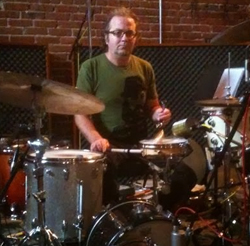
Do you any mic preferences on your drums?
Depending on the engineer and the producer, if they have a preference I’ll go with what they want, but I gotta say I really love a [Neumann] FET-47 on the outside of the kick drum. That’s one of my favorite mics. I like ribbon mics a lot for room and overheads. I like the Beyer M-160 ribbon on the hat. That warmed it up a lot.
I did a session the other day where we used Sony C-37s on the toms (which haven’t been made since the late 60s) and they sounded amazing. The producer said, “If you weren’t the drummer, I wouldn’t put them up,” because they’re so fragile that you have to be afraid of hitting them. That was really quite a compliment. Then again, some people get great results from Sennheiser 421’s.
I don’t generally do top and bottom mics on the toms. I don’t like too many mics on the drum kit unless the producer and engineer are really paying attention to the phase cancellation, but I have had good results with people who have done it that way.
I walked into a session with a metal producer who shall remain nameless, and he had the kit miked up with what looked like 40 microphones. I thought, “This is ridiculous,” but I played the track and it sounded amazing. Then sometimes I’ll work with just three mics on the kit and it will sound great too.
Everybody has their own technique and I try to be flexible because most of the people that I work with are so high end that I trust them to get my drums sounding the way they want them to sound.
You mentioned before about Patrick Leonard inviting you to LA to record. Would you consider that your big break?
I think so because after we finished that I record I was pretty much planning on moving back to the Bay area, but Patrick said, “Hey Brian, if you lived in LA I would use you on the records I work on.” Ironically the engineer/co-producer on that record was Bill Bottrell (who eventually went on to produce Sheryl Crow, Michael Jackson and Shelby Lynn) and he said the same thing to me. So I had two top-of-the-line producers tell me that if I lived in LA they’d use me on their records. It became a no-brainer for me to run up to the Bay area, pack my things in a U-Haul, and get my butt to LA. Then it kind of expanded from there.
I had no delusions of moving to LA before those sessions. I was too content up in the Bay area where I had a nice life teaching drums and playing live almost every night. It was wonderful, so I really didn’t want to move to LA unless there was a good reason because I didn’t just want to try to break in the way everyone seems to do it. It would have been too frustrating for me.
Do you have any other advice for a young drummer just starting out?
Yeah, I’d say try to play to a click as much as you can so you can learn to play with it yet lose sight of it at the same time. You want the feel of the click track to become like intuition, so it doesn’t make you feel shackled to it.
Also, when you work with a producer, be as flexible as you can be. Don’t be stubborn and trust the people you work with. If the engineer or producer has a suggestion, trust their advice. I was talking to a producer the other day about he’ll sometimes have a drummer come in that will insist on playing his own kit.
If I work with a producer that wants me to play his old vintage kit, of course I’ll play it because I think it’s important to be flexible. Even if you show up with your gear, if he has his kit miked up and he knows what it sounds like, I’ll generally do that. If they’re not satisfied after that, then I’ll use my drums.
Another thing, if you have any ideas, make the suggestion if the time is right because it’s all about teamwork and you’re on the team.
Bobby Owsinski is an author, producer, music industry veteran and technical consultant who has written numerous books covering all aspects of audio recording. Get The Drum Recording Handbook here.
